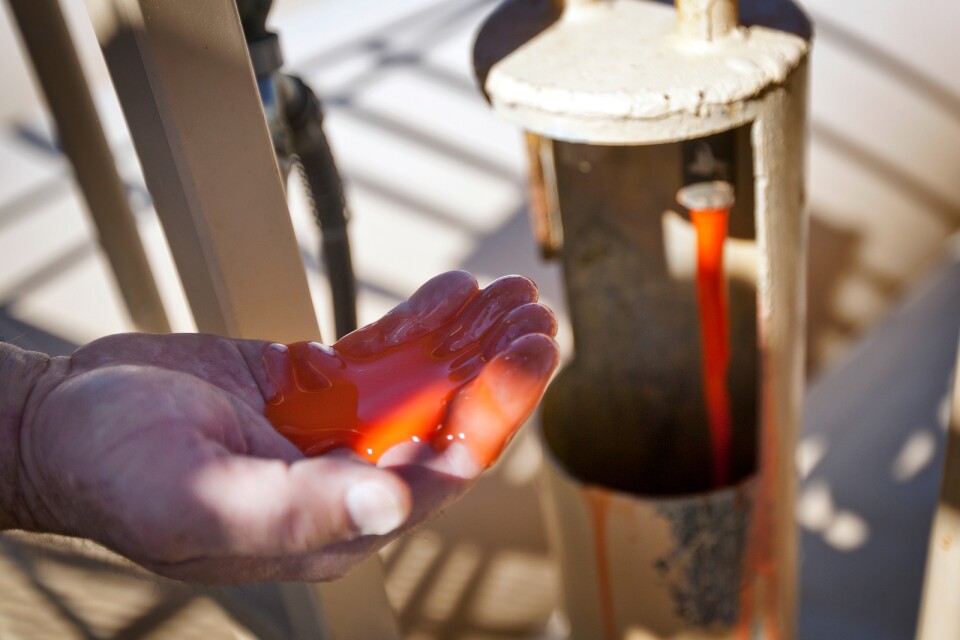What the big automakers are planning for the future, Chip Kelly's controversial past, how California's increased use of fire retardant is harming the environment.
'We have rapists in this building': CA Assembly examines harassment reporting in Capitol
Workplace harassment continues to dominate the headlines this week.
On Tuesday, there was yet another prominent resignation from NPR, after at least three women accused former Chief News Editor David Sweeney of harassment.
That was followed by more surprises, as harassment claims led NBC to fire longtime "Today Show" anchor, Matt Lauer, and Minnesota Public Radio severed ties with Garrison Keillor, the former host of "A Prairie Home Companion" after allegations of inappropriate behavior.
And that's just in the media sphere.
Meanwhile, in California's Capitol, a new committee has begun examining the way the state Assembly handles claims of harassment.
"What everybody knows here is that we have rapists in this building," California Democratic Party Women's Caucus chair Christine Pelosi told the committee.
KQED's Katie Orr tells Take Two she was at that meeting, where few people seemed surprised to hear that harassment persists in the Capitol:
Even the Assemblywoman Laura Friedman, who was leading the subcommittee, said everyone [has] heard these stories. We all know that this goes on. The Capitol is having a reckoning of its own of sorts. We've already seen the fallout from that: Los Angeles Assemblyman Raul Bocanegra resigned on Monday following several accusations against him. Senator Tony Mendoza has been stripped of his leadership positions following accusations against him. This is something the Capitol is dealing with, and we don't know that it will slow down anytime soon.
Press the blue play button above to hear the full interview.
No one really knows what’s in fire retardant — but it’s affecting fish and plants
So far this year California has dropped 15 million gallons of fire retardant on burning forests and hillsides across the state.
But here’s the thing: No one really knows what it's made of — or its full environmental impact. The ingredients are protected as trade secrets under federal law, but they’re affecting plants and animals and humans.
The chemical powder is a flame retardant, used to slow down fast-moving fires to clear the way for ground firefighters. It's considered a vital firefighting tool, but this year California has dropped a new record amount, that's double what it was three years ago.
So, with the increase in drops, what are the repercussions on the environment?
Matt Weiser from News Deeply spoke to A Martinez about the four things worth considering about California's increased use of fire retardant.
No one really knows what it's made of
The retardant powder ingredients are protected as trade secrets under federal law.
"But we do know that the main ingredient is some type of ammonia compound," explained Weiser, "mixed with a gelling agent of some sort that is meant to cause this chemical to stick to plants."

It has an effect on plants, wildlife and even humans
Effect on fish
Weiser cited a study that can kill salmon at "less than one percent of the concentration at which it is applied." In other words, fire retardants remain deadly to fish even after they're diluted in their environment.
Effect on plants
Because their main active ingredient is ammonia, a key ingredient in fertilizer, it's been found that these retardants become a powerful fertilizer for plants in the aftermath of fires. This is true for invasive non-native plants in particular.
Many of these plants are "better able to colonize burned areas after a fire," said Weiser. "They actually feed on the ammonia in these retardants and they can crowd out the native plants."
The result of this phenomenon changes the habitat of the affected area considerably.

What about humans?
There are no studies that look into the effect on humans once the retardants are applied. However, they can be harmful to those who mix it.
"These things are usually delivered as a powder and then mixed with water before being pumped onto a plane or a helicopter. If the people mixing them on the ground breathe the power excessively, it can cause health problems."
You can expect fire retardant use to increase
"One of the situations we have with a lot of wildfires these days is they're occurring closer and closer to developed areas and that's largely because we're developing in areas that are more likely to burn."
These areas are known as wildland-urban interface. A lot of burning happened in wildland-urban interfaces during the October Sonoma and Napa county fires. The fires that devastated Santa Rosa occurred in areas that had burned in a large fire 50 years ago, but there were no homes there back then.
There is an alternative
An alternative has been developed by a company in Georgia called "Hazard Control Technologies," according to them, their retardant is less harmful than the ones being used now by Cal Fire and the U.S. forest service.
But don't expect to hear about this new Georgia retardant being used by the forest service anytime soon.
"It doesn't meet their testing protocol. The company claims that the test protocol is outdated and needs to be revised."
To hear more about fire retardant and its effect on the environment, click the blue play button above.
California could lose $2.7 billion in kids' health funding and there's no backup plan
Buckle up, the road ahead is driverless: News from the LA Autoshow
As the LA Auto Show gets ready to open its doors to the public this Friday, car companies are beginning to reveal details about the new vehicles and services that will become available to consumers in the coming years.
Volkswagen
At an event in Hollywood, the beleaguered German automaker declared its reinvention as an electric car company, saying the transformation was the result of its recent diesel emissions scandal.

Volkswagen revealed three all-new battery electric vehicles:
-
An all-new electric compact SUV that will be available in 2020, based on the ID CROZZ concept sedan.
-
The ID BUZZ, an all-electric version of the iconic Volkswagen bus, will go into production in 2022.
-
There's also an ID hatchback that will become available, starting in Europe and Asia.
While Volkswagen credits the diesel emissions scandal for its new embrace of electric cars, Jurgen Stackmann, member of the board of management for the VW Brand, say "without Tesla and Elon Musk, the world would not have accepted that electric cars are sexy... Without him, we wouldn’t have been so bold to take our step."

Waymo Transportation Service
Waymo is Google’s self-driving car spinoff. Company CEO, John Krafcik, revealed a few more details about its driverless mobility service, officially called the Waymo Transportation Service. Since the spring, Waymo has been operating an Uber-like service in Phoenix, and will soon begin offering a truly driverless version.
When Waymo expands its Transportation service, according to Krafcik, it is likely to be in an area contiguous to Phoenix. Waymo has also put its autonomous driving system into a Class 8 truck and is working with various logistics companies.
Hyundai BlueLink All-Access
Car companies aren’t just making cars: They’re also offering a lot of services.
Hyundai has announced a partnership with a company called Smartcar, which will let drivers of Hyundai cars equipped with its BlueLink connected car platform to communicate with outside apps to grant the car access for things like grocery and dry cleaning deliveries. The car’s driver would not need to be with the car.
Through BlueLink All-Access, the service locates the car, then unlocks it so the service can be performed and re-locks it once the service is complete. BlueLink All-Access will launch in the first half of next year as a pilot program with various California businesses, including Washos, an on-demand car wash service in LA.
Yes, new car technologies will grant you yet another way to avoid human interaction, should that be your wish.
Lincoln Motor Co.
Lincoln also announced a partnership with a company called CLEAR, that will allow Lincoln owners to skip the security lines at airports and major sporting events using a special CLEAR lane inside the venue.
Lincoln is experimenting with all kinds of services, including at-home test rides, where the car is left with the potential buyer for 24 to 48 hours, and something called Lincoln Personal Driver, which lets Lincoln owners hire drivers to drive their cars and run errands for them.

GoKid Carpool App
One of the finalists in the automotive startup competition at Automobility was the GoKid carpool app, designed for parents and schools. It was started by a mom in Connecticut who was frustrated with being stuck in traffic jams with her neighbors as they all drove to the same place at the same time with their kids in tow. Unlike HopSkipDrive, which hires drivers to transport children, the parents are the drivers with GoKid.
To hear more about what's being discussed and showed off at the LA Auto Show, please click on the blue player above, or click on these related stories:
LA Auto Show: cyber security, automobiles and you
K2 Sports: a new face for UCLA football
In college sports, changing head coaches every few years is nothing new. Many think it sort of comes with the job, you're hired - and if a team doesn't win ... you're fired.
UCLA football made a hire this week, one that that seems a bit out of character for the University. On Monday, former Oregon coach Chip Kelly was introduced as UCLA's new football coach.
We'll talk about that and a lot more with Andy and Brian Kamenetzky.
Is your neighbor partying too loudly? LA City Council is proposing a fine
Perhaps this has happened to you: A neighbor throws a party and things just get way too loud, and go way too late.
You might politely ask the offenders to turn it down - or you could call the police to do just that. Either way, it's not fun.
It's become a big problem in Los Angeles, especially for residents living in and around the Hollywood Hills. That's thanks to a rise in year-round rentals that are often being used solely as event spaces.
"There are party houses in the hills that were purposefully built to basically be event places in a residential area, and that are hosting 500 people every weekend of the year," said Nick Greif, policy manager for LA Councilman David Ryu.
Ryu serves many of these residents in the Hills who are being affected, like George Skarpelos, vice president of the Hollywood United Neighborhood Council.
"It's not simply about a loud party, it's the use and abuse of these residential areas for commercial and residential purposes," he said. "What we want to see is the city have an increased ability to enforce the laws that exist."
Yesterday, the LA City Council's Planning and Land Use Management Committee proposed some regulations that are expected to be voted on by the full City Council before Christmas.
"The current rules are easy to abuse - the one and only rule you are really violating is the noise ordinance - that makes it really hard to keep people from doing this every weekend," said Greif. "What we want to do is disincentivize future infractions, so we've created an escalating set of fines which start at $100, but escalate it for the folks who are doing it every weekend up to $8,000 for a sixth offense."




